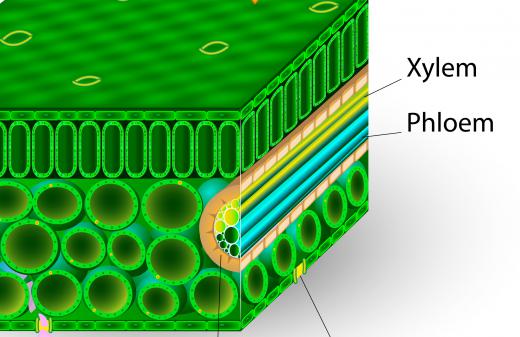What is a Xylem Cell?
 Mary McMahon
Mary McMahon
A xylem cell is a cell which is responsible for providing support to a plant. These cells also make up the vascular system of plants, conducting water throughout the plant and providing circulation. These cells can be both alive and dead, and there are several different types of xylem cell which can be found within the parts of a plant known collectively as xylem.
Plant cells start out as undifferentiated parenchyma cells. These cells can store energy for the plant, and they can also differentiate and mature into various cell types, including xylem cells. The xylem of plants usually contains a number of parenchyma cells, leading some people to classify them as a type of xylem cell, although this is technically incorrect.

Support is created through trachieds and fibers, cells which contain a great deal of lignin in their cell walls. The lignin makes the cell walls rigid, making the xylem as a whole very stiff so that it will support the plant and keep it upright. Trachieds are also involved in conduction, as are cells known as vessel members. Vessel members are tubular xylem cells which are designed to force water up against the pull of gravity so that it can circulate into the upper reaches of the plant.

When xylem cells die, they are still useful to the parent plant, unlike dead animal cells, which are usually broken down and discarded because they no longer serve a function. Although a dead xylem cell is no longer able to perform complex biological functions, it can still act as part of a support network for the plant, because the lignin in the cell walls is intact. These cells can also continue to conduct water through the xylem after death, because their conductive properties are purely mechanical, created by the shape of the cell, rather than being biological in nature.

Without xylem cells, a plant would have no vascular system. Vascular plants are able to be much more complex than their non-vascular counterparts, and they could be considered an evolutionary step up from nonvascular plants. Vascular plants may also be referred to as “woody plants,” because their xylem gives them a woody texture and the ability to grow large, upright, and complex. Woody plants serve a number of important ecological functions, and they are also highly prized as ornamentals in gardens all over the world.
AS FEATURED ON:
AS FEATURED ON:













Discussion Comments
Xylem transports water by killing itself.
What are the cell parts involved?
@Hilliards - This works because it keeps the same osmotic pressure at the base of the plant. People see longer lifespans on their roses, and other flowers when they cut the xylem while it is submerged. I have to argue a different point, however, regarding nutrients.
In plants there is xylem and phloem. It is phloem that is responsible for nutrient transfer. I forget the direct mechanisms, but I think the xylem cell structure doesn't allow for nutrient transfer. Hence the importance of phloem.
@deany17 - It makes sense to me that xylem transports the nutrients found in such "plant foods." In addition, it's really useful to cut the stems of plants while they are under water. This allows the water to stay in contact with the end of the xylem. I was taught this in high school biology, xylem should be cut under water!
Xylem cells act as water conducting pipelines that give support to the structure of the plant. Minerals that are dissolved in water are also transported through the xylem cells. When you buy garden products that "miraculously" grow your plants in a short time, are they transported through the xylem to affect the tissues necessary for growth?
Post your comments